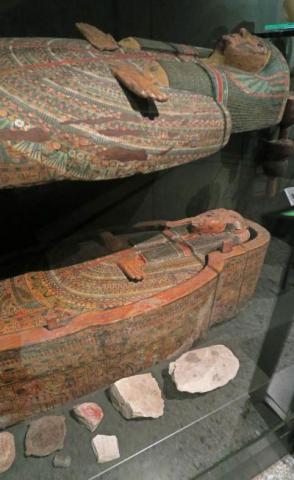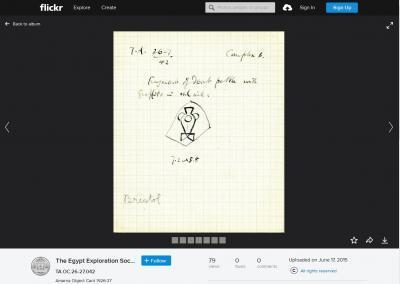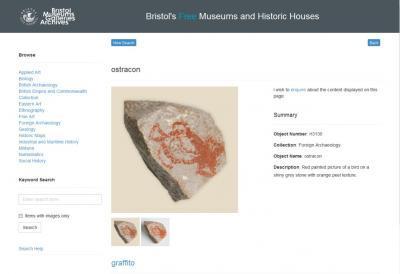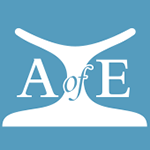The Egypt Exploration Society and the Bristol Museum
By Alix Robinson
As part of the Artefacts of Excavation project, I have been working on the distribution section of the Lucy Gura archive at the Egypt Exploration Society. One of the aims of the project is to facilitate the examination of the relationships between archaeology, Egyptology, and museums. I have been investigating the relationship between the EES and the Bristol Museum, and I think the project has definitely achieved this aim!
Prior to working with the EES, I had visited the Bristol Museum and been impressed by their Egyptian collection, and also curious as to how and why they had come to have it. So I found it very interesting when in the process of scanning the EES Distribution archive, I came across evidence of a close relationship between the Egypt Exploration Fund (as it then was) and the Bristol Museum. I was lucky enough to be able to follow up my initial research at the EES with a visit to the Bristol Museum to look at related materials in their archive, which provided even more of the story.
My first find was a letter in the EES archive, written by David Randall-MacIver, who was working on the Egypt Exploration Fund excavation at Abydos. On July 21st 1901, he writes to the Secretary of the EEF saying, “The four museums viz Ashmolean, Pitt-Rivers at Oxford, Ethnological & Archaeological at Cambridge, and the Bristol Museum, which are the only ones to receive gifts of any appreciable value do not stand in need of recommendation. If a valuable assignment is suggested for Bristol it is because the city is greatly enlarging its museum premises and is showing a very keen interest in the Egyptological part of its collections.” Just how keen, I discovered during my research at the Bristol Museum.
The curator at Bristol who took such an interest in Egyptology was Herbert Bolton. The archive at the Bristol Museum contains a letter dated July 19th (presumably 1901) from David Randall-MacIver to Herbert Bolton, in which he encloses “a rough inventory” of objects intended for the museum, which he is certain will be approved by the committee of the EEF “on the understanding that proper case-room is provided for them.”
Next, there is a letter dated September 21st 1901, from David Randall-MacIver to Herbert Bolton, in which Randall-MacIver writes, “I have made a complete revision and rearrangement of all the objects of the pre-dynastic and proto-dynastic periods which the Museum possesses.
For this purpose I have taken out of the cases all the specimens which the Museum possessed previous to the present year. Next I have unpacked and put in order the large consignment of antiquities belonging to the same period which the Egypt Exploration Fund has this year presented to the Museum.
Those antiquities all came from the excavations conducted by myself at El-Amrah (1900 – 1901) so that I have been able to supply all details concerning them.”
He goes on to further describe the arrangements in detail, and mentions that he has supplied plans and photographs of the tombs to complete the arrangement. (At this point, I am somewhat in awe of Randall-MacIver, who has persuaded the EEF to make the donation, and the Bristol Museum to provide a greatly expanded space to house it, thus gaining the opportunity to display his own finds exactly as he would wish.)
In fact, at least some of the specimens previously displayed at the museum were also donated by the EEF. Materials in the Bristol Museum archive indicate donations were made in 1884, 1886 and 1887. Of particular interest is a display card for a set of amulets “mounted exactly as found upon a mummy”, and noted “presented by the Egypt Exploration Fund”. The card bears the date 1886 crossed out and replaced by 1884. As it is written on the back of an invitation to the opening of the Bristol Medical School’s new wing on the 16th of November, 1892, it is reasonable to suppose that these were among the items present in 1901. (I admit to a fascination with this use of spare invitation cards and whatever else came to hand for writing on; it’s common in the EES Distribution archive to find lists written on the back of other things.)
From this auspicious start, there follow more donations of antiquities from the EEF. In a letter dated September 14th 1904, the museum thanks the EEF for 15 cases of antiquities, so it’s evident they were still receiving substantial amounts of artefacts. Apparently, one of these was an unexpected earthenware mummy case: the museum sent a letter enquiring about it on the 29th of September, 1904; they had restored it and wanted to know its provenance. In the Bristol Museum archive, I was delighted to find the reply from Emily Paterson, saying that it was from Gurob, and XIXth dynasty.
In 1905, however, Bristol apparently did not receive everything they wanted. The EES archive contains a list of items requested from the 1905 exhibition. These exhibitions were held in order to display items brought back from that year’s excavations (Deir el-Bahari in 1905), and museum curators were encouraged to attend, and to request specific items for their collections. Bristol requested a number of items. However, their letter of thanks, dated 28 September 1905 mentions receiving a mummy and a mallet, just two items, only one of which was on their list.
From 1905 – 1911, Richard Quick took over curation of the Egyptological section of the museum. Herbert Bolton remained as Director, taking over from Quick again after that. There is some correspondence from Richard Quick in the EES archive, including an interesting discussion about a mummy case which arrived in 1905 and was put on display in 1906 missing a bit from the foot. On the 2nd of March, 1906, Richard Quick writes that they “should be glad to have the missing piece at your earliest convenience, as the case is now on exhibition.” He writes again on the 10th of March to say that the piece has now arrived, though I have been unable to ascertain whether the repair was ever carried out.
By 1913, the relationship between the two institutions seems distinctly cooler, with Herbert Bolton writing on August 26th 1913, “The specimens mentioned in your letter, and in that of Miss Paterson’s of the 18th inst., have duly come to hand, but I extremely regret their fewness and unsuitability for our collections.”
In 1920, there is a carbon copy of a sent letter beginning, “I find that the name of your museum still appears on our books and lists of subscribers, but no subscription seems to have been paid for a good number of years.” This letter is dated 12th March, and addressed merely to “the Curator, Bristol Museum”.
Herbert Bolton replies the very next day, on the 13th of March promising to re-subscribe when funds are available, perhaps in a year or so, but adds the following: “If your Society could devote one section of its work to the furnishing of museums with representative series of material of as many dynasties as possible, I think you would do much to increase an interest in Egyptian work, and would enable museums also to assist schools to a greater degree than they can now do.”
He is not alone in this change of attitude – around this time the EEF received a number of similar letters from other museums which have gone from expressing gratitude for the objects allocated to them, to sending in long lists of desired objects, to demanding objects which would complete their collections.
By 1924, Bristol are once again subscribing and receiving antiquities. Herbert Bolton writes, dated 1st August 1924, “I am rather disappointed with the collection and would much rather another year have one or two good specimens than so many small unimportant ones.” He goes on to suggest that museum curators should have a meeting with the excavators before the winter digging starts, to discuss how to supply the museums’ requirements!
The reply from the EEF, dated 5th August 1924, of which again there is a carbon copy in the archive, reads: “With regard to your suggestion that Curators of Museums should meet the excavators before the latter proceed on an expedition I do not think that any useful purpose would be achieved, as the excavators are only able to bring home what they dig up, not what the Museums specifically ask for.”
Fortunately, this did not discourage Herbert Bolton too much, or I would not be able to present you with the final result of my research: one of the best-documented objects donated to the Bristol Museum by the EEF.
In 1927, the EEF donated an ostracon to the Bristol Museum. It is unusual in that its photograph was published in The City of Ahkenaten Part II, where the drawing on it is described as “a design of a pot”. It is listed in the same publication as having been sent to Bristol. In addition, also in the EES archive is its object card, which can be found in the EES object card collection on Flickr.
This ostracon can also be found on the Bristol Museum website, which describes the drawing as “a picture of a bird”. Although the description of the drawing differs, the photographs and object card provide evidence that it is the same artefact.
Here it is, on display in the museum. It might be a bird, or a pot, or something else entirely, but it’s certainly evidence of a long-lasting relationship between the Bristol Museum and the Egypt Exploration Society.

Ostracon from EES work at Amarna on display in Bristol Museum. Photograph by Alix Robinson

EES archive record for the ostracon now on display in Bristol Museum

Bristol Museum's online catalogue entry for the ostracon from the EES
